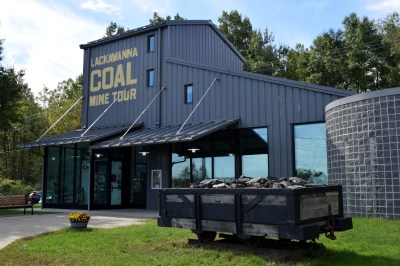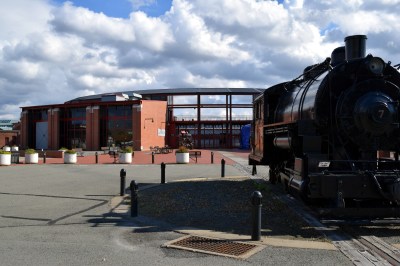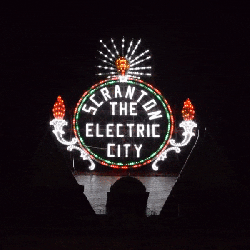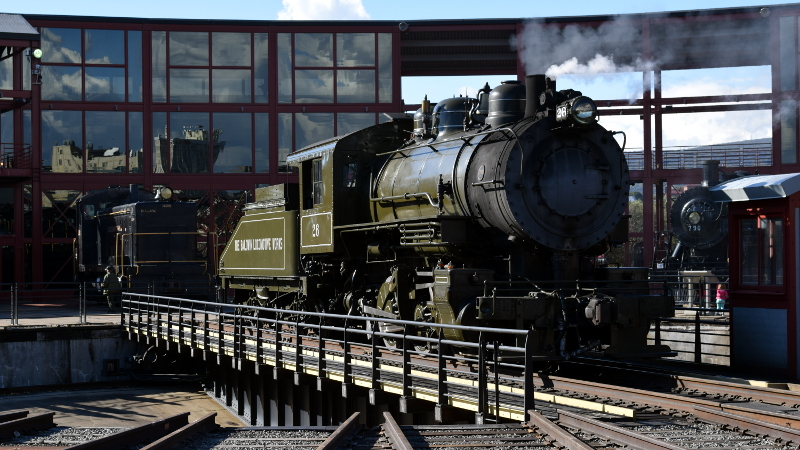Much to the chagrin of local historians, the city of Scranton, Pennsylvania is today best known as the setting for the American version of The Office. But while the exploits of Dunder Mifflin’s best and brightest might make for a good Netflix binge, there’s a lot more to the historic city than the fictional paper company. From its beginnings as a major supplier of anthracite coal to the introduction of America’s first electrically operated trolley system on its streets, Scranton earned its nickname “The Electric City” by being a major technological hub from the Industrial Revolution through to the Second World War.
Today, the mines and furnaces of Scranton lie silent but not forgotten. In the 1980’s, the city started turning what remained of their industrial sites into historic landmarks and museums with the help of State and Federal grants. I recently got a chance to tour some of these locations, and came away very impressed. They’re an exceptional look into the early technology and processes which helped turn America into an industrial juggernaut.
While no substitute for visiting these museums and parks for yourself, hopefully the following images and descriptions will give you an idea of what kind of attractions await visitors to the modern day Electric City.
Lackawanna Coal Mine Tour
 As Scranton is best known for its anthracite coal, it seems fitting to start with the “Lackawanna Coal Mine Tour” located in McDade Park. This abandoned mine was opened to the public as a museum in 1985 so that visitors could see what it was like to actually work hundreds of feet underground inside of a coal vein. Though it should be said that the experience for the actual miners, who worked the mine from 1860 all the way up until 1966, wasn’t quite so luxurious. Electric lighting and reinforcing timbers were added for the safety of visitors; the actual miners worked in complete darkness and without the comforting presence of the overhead supports.
As Scranton is best known for its anthracite coal, it seems fitting to start with the “Lackawanna Coal Mine Tour” located in McDade Park. This abandoned mine was opened to the public as a museum in 1985 so that visitors could see what it was like to actually work hundreds of feet underground inside of a coal vein. Though it should be said that the experience for the actual miners, who worked the mine from 1860 all the way up until 1966, wasn’t quite so luxurious. Electric lighting and reinforcing timbers were added for the safety of visitors; the actual miners worked in complete darkness and without the comforting presence of the overhead supports.
On the surface there are various pieces of equipment on display and a small museum with requisite gift shop, but the main attraction is what’s known as the “#190 slope”. Visitors are issued hardhats and pile into a squat yellow vehicle that descends the slope to a depth of approximately 76 meters (250 feet) below the ground. Most people never get the opportunity to travel this far below the Earth’s surface, so to say it’s a unique experience is something of an understatement.
At this depth it’s always about 12 C (54 F) and water constantly runs down the walls at an alarming rate and with an unnerving sound. Despite the millions of dollars invested in turning the mine into an attraction for the public, it’s not always easy to navigate its meandering tunnels. The ground is occasionally uneven and loose, and at points the ceiling is very low. Even with the lighting installed at regular intervals, sections of the mine are still incredibly dark, and it can be difficult to see low outcroppings of rock.
Anthracite Heritage Museum
Also located in McDade Park, the “Anthracite Heritage Museum” features exhibits dedicated to the technology used to mine and utilize coal. Hardware that would have been used in or around the mine such as drills, crushers, and conveyor belts are on display. Most of the equipment is shown in tableau, which allows the visitors see how the pieces of machinery would have worked together to release the coal from the Earth and transport it up and out of the mine.
Electric City Trolley Museum
This museum is dedicated, as the name implies, to the electric trolley system which helped put Scranton on the map in the 1880’s. Highlights include a restored trolley featuring a cut-away so visitors can inspect the motor and gearing system, an explanation of contemporary power handling equipment, and a wide array of ancillary equipment on display such as relays and transformers.
The Trolley Museum is a wonderland for those who are interested in high voltage or turn of the century technology, and they even offer (for an additional fee and subject to weather) excursion trips on early 20th century trolleys. But it should be said it’s one of the smaller museums in the city, and visitors shouldn’t expect to spend more than an hour or two here if you aren’t taking one of the trips.
Steamtown National Historic Site
 Truth be told, I wasn’t terribly keen on visiting what I perceived to be a “Train Museum” at first. There are many people who are fascinated with trains and the romance of old-time steam locomotives, but I’m certainly not one of them. I assumed the “Steamtown National Historic Site” would be of limited interest to me, but being highly recommended and part of the National Park Service, it seemed like I’d have to at least give it a chance. Besides, admittance is free.
Truth be told, I wasn’t terribly keen on visiting what I perceived to be a “Train Museum” at first. There are many people who are fascinated with trains and the romance of old-time steam locomotives, but I’m certainly not one of them. I assumed the “Steamtown National Historic Site” would be of limited interest to me, but being highly recommended and part of the National Park Service, it seemed like I’d have to at least give it a chance. Besides, admittance is free.
In the end I’m very glad my general disinterest in the iron horse didn’t keep me from visiting. In all honesty, I don’t remember the last time I was so impressed with a museum. The presentation and attention to detail at Steamtown is absolutely phenomenal. I came in with a vague understanding of how these vehicles operated, and left with a deep respect for the engineering required to not only construct these behemoths in their prime, but continue to run and maintain them into the present day.
The term “up close and personal” really describes the experience here perfectly. You’ll get not only the opportunity to take a ride on a nearly 100 year old coal-fired steam train but stand mere feet away from the beasts as they meander through the complex, whistles screaming and pistons pounding. Even if you’ve got zero interest in these machines going into the museum, it’s exceptionally difficult not to be in awe of them when you can feel the heat of the boiler and smell the coal burning.
While the trains themselves are probably the biggest draw, the exhibits inside the museum are also fantastic. A good portion of them are dedicated to the socioeconomic aspects of rail travel in 1900’s America, but there’s also an entire wing devoted to train technology. Here every system of the locomotive is broken down and explained, as are the more practical aspects of running the rail service such as signaling. A major highlight of the technology wing is a locomotive which was fully restored and then cut in half down the length, so visitors can look inside its major components to better understand not only their inner-workings but their enormous scale.
Worth the Trip
 These are arguably the best known of the museums in and around Scranton, but by no means the only ones. I simply ran out of time during my stay, and didn’t get to check out a few of the other museums or attractions that had caught my eye, notably the iron furnaces. To fully explore just the locations I’ve listed here you should plan on a stay of two or three days, especially as some of the museums close by early evening. If you want to take the train or trolley excursions, each one of those will eat up most of the day itself.
These are arguably the best known of the museums in and around Scranton, but by no means the only ones. I simply ran out of time during my stay, and didn’t get to check out a few of the other museums or attractions that had caught my eye, notably the iron furnaces. To fully explore just the locations I’ve listed here you should plan on a stay of two or three days, especially as some of the museums close by early evening. If you want to take the train or trolley excursions, each one of those will eat up most of the day itself.
Beyond the historical and technological attractions, I found Scranton to be a charming place with a surprisingly vibrant nightlife in the city center. This is a particularly nice counterbalance if your traveling companions aren’t necessarily the type to enjoy exploring a coal mine all day. I fully expect to return to Scranton in the future to hit a few of the spots I missed this time around, and I’d wholeheartedly recommend it as a destination for anyone in the market for a somewhat rural vacation with a side of century old technology.


































IIRC, the Steamtown museum is a congressman’s pet pork project.
Always did want to see “The Museum of Pork”. The trolley museum should really trigger this group.
Don’t you mean this???
B^)
https://www.spam.com/museum
Been there, done that, worth the side trip.
Well…sorta. https://en.wikipedia.org/wiki/F._Nelson_Blount
Pork that preserves history, and provides education, is a pork meal meal many can tolerate.
Not to be pedantic but since stratigraphy is “the triumph of terminology over reason and common sense”, its a little cringey to me but no one else probably cares. A “vein” is a sheetlike body of rich ore deposited by hydrothermal means. Coal is sedimentary, so “bed” would be the typical term or “seam” which was used in the past to describe an economically viable bed but has since fallen out of usage.
What a pleasant surprise to see this article. I grew up in the area an hour or so south of Scranton. I had many older relatives who worked in the mines and on the railroads, and still remember climbing the coal piles and watching the steam powered shovels strip mining for coal. One of the most amazing things was the fossils. The areas where we played had a lot of shale. When broken open, about every third stone would have a plant imprint of some sort. It wasn’t until I left home for school I realized this wasn’t typical.
Aack, meant to post here!
Now I look like a crazy idiot reacting to the article!
@olsen now I’m realy confused ….
The reasoning is that the economic value of a healthy environment outweighs the economic loss taken from decreasing fossil fuel consumption.
Also, are you seriously considering restoring and using 100+ YO steam engines and coal mines to save money? I think you’re living in a glorious past that never was. One of the advantages of “green” energy is an increase in the diversity of power sources, strengthening the grid and curbing the impact of any one disaster at any one powersource. For hundreds of years coal has been a cheap and stable power source, but its environmental impact is detrimental to business.
Kind of a bummer the removal of the electric public transportation systems that used to be more prevalent throughout the U.S. Figures, before or around the time nuclear plants were implemented.
Nasty from the earlier coal era time frame… is the early oil industry that used only the whale oil replacements distillate fraction and dumped everything else down stream to pollute. I think that like other coal or oil industry waste streams pollution is overlooked now days as a causation or root cause for issues historically.
Definitely nice to have a cleaner environment than the smog laced sky and ground, maybe even still in some locations, period of little more than two decades ago. Coal is still in use and pollutes more than nuclear. Maybe bromine scrubbers can be implemented more to clean and refine the waste stream.
I’m still for a U.S. Mexico Border wall that is a solar concentrating trough array (maybe multi-story enclosed matrix). That would be intense and more profitable. Can be used to recycle nuclear waste, mine raw materials from sea water and even as remote sensing systems.
Wouldn’t save money at all because labour is expensive these days. However, if someone wants to, I’m fine with it so long as they adequately offset their emissions.
I thought this was going to be about the Akihabara, but it was something quite interesting instead!
Thanks for taking the time out and doing the tours here. I used to travel a ton through I-81/Scranton/Wilkes-Barre to get visit family in Virginia as I traveled from upstate NY. I would see the exit signs, the billboards, but had no time to visit. I may take some time now to visit knowing what’s there.
Coal cracker here; I feel like this is some sort of hidden advertisement by the city of Scranton (I would like clarification by the author regarding that). It is BY NO MEANS the place to go. The museums there are “okay” compared to several other ones located throughout Pennsylvania. For example the number 9 museum in Lansford. What not many people know, is while Centralia (the town silent hill is based off of) does have an underground mine fire, there’s absolutely nothing to see except for the graffiti road and you’d be wasting your time visiting it, there is literally a clearly visible fire burning in Lansford in the woods nearby the radio station which looks like hell on earth. They say “Steamtown museum” and I hear “Steamtown Mall” which is by any measure a dead mall nobody goes to and its biggest attraction is a mediocre aquarium. Scranton is the worst place in America. The place is terrible and decently dangerous at night. Only “nightlife” are old coal bars and a strip club.
Tom, this piece is interesting and I’ve placed the big museum on my to-do list for next summer!
Have you been to The Henry Ford Museum in Michigan? It’s expensive, but you can easily spend several days. Pick whichever day has the nicest weather, and do Greenfield Village, which is the outdoor portion. Numerous historical buildings, picked up from wherever they were, and moved to the museum grounds for preservation — you’re walking on the very same timbers that Edison walked on, not replicas.
We have been to Henry Ford and it was well worth it
But did you go to Alfredo’s Pizza Cafe or Pizza by Alfredo?
If you ever get the chance to go back, you should try to make it a few hours north to Corning, NY. They are one of the most well known producers of glass products in the world and the city is rich with history. They have the world’s largest glass museum that everything from art to industrial production, and live hot glass blowing shows all day!!
When I went onsite to train on the OGP Smartscope Flash 500 I was wondering about Corning though didn’t research enough. I’ll have to put that on my must do list. Greenfield Village and The Henry Ford Museum are awesome for sure as well as The Museum of Science and Industry if you’re in Chicago ever. I didn’t do the Ford Rouge Factory as I’m not sure was available way back when I did, though have on my list to do. However, I saw the 2017 solar eclipse from the Evansville Toyota Plant and did the plant tour there before the eclipse.
The whisper dishes at The New Mexico Museum of Space History are also really worth checking out and experiencing as well as other National Parks and Museums in the area.
A.E. Seaman Mineral Museum of Michigan Tech is worth the trip as well as Copper Country Cruising visiting historical sites and I see the Quincy Mine is open now which looks interesting as I used to play around those areas when I was a child. Any mine or cave tour I’ve been on is well worth the time. Looks interesting and is eye opening experiencing the history of raw material sources up close. Coal definitely has quite a rich history.
Coal is hauled on the rails. Rails were made in the steel mills. Steel mills were fed with coal, making more steel as rails to haul more coal on. It was a beautiful thing, the “circle of life” of the industrial revolution. :-) Other, less poluting, circles may be very buildable in this day and age, and that’s how you get a wealthy industrial society, unless one preffers mucking about in the field with wooden tools.
Since this was written, Scranton has also become famous as the birthplace of President Joe Biden. The short highway that runs from I-81 near Nay Aug Park to the Lackawanna Ave entrance to the city near the University of Scranton is now named for him.
There was indeed some pork involved in the formation of Steamtown. The original Steamtown USA, mostly based on the train collection of F Nelson Blount, got some government money to assist its move from Vermont. After it went bankrupt in 1986, the site was taken over by the National Park Service, which made substantial improvements and reopened it in 1995.
Scranton was the headquarters of the Delaware, Lackawanna, and Western Railroad (DL&R, most popularly known simply as the Lackawanna), which touted the clean nature of its anthracite-powered steam passenger trains. Scranton and the area of northeast Pennsylvania around it was a center of anthracite mining, and the primary business of the Lackawanna was transporting coal. The railroad had a magnificent home station and headquarters, which is now the Radisson Lackawanna Station Hotel Scranton; the exterior and some features of the interior have been preserved. The hotel is a short walk from the historic site, and the scenic trains from Steamtown stop there.
Although there were initially questions about the historic significance of the train collection (it has since been upgraded with the sale of some of the original Blount collection and acquisition of trains that are more historically relevant to the site in Scranton), the Steamtown National Historic Site has become a worthy part of the National Park system.
There is hope that passenger rail service to Scranton will resume someday, as a joint effort of New Jersey Transit, the Pennsylvania Northeast Regional Rail Authority, and Amtrak. NJ Transit’s Morristown line runs on the former main line of the Lackawanna, and is currently being extended from its current end point in Dover to Andover; that service is scheduled to start in 2026.
If you’re traveling to Scranton, I also recommend a side trip to nearby Old Forge to try the town’s unique style of pizza. If you’re not up to getting there, Revello’s (an Old Forge pizzeria) has a small outpost inside the Marketplace at Steamtown, a not-exactly-thriving shopping mall next door.